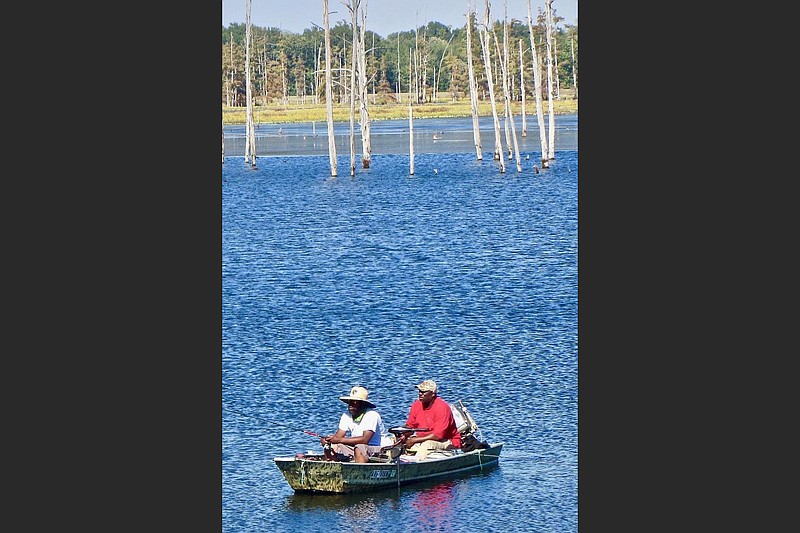CANE CREEK STATE PARK — Fishing is the primary lure for many visitors to Cane Creek State Park. But the 2,053-acre preserve, 75 miles southeast of Little Rock, also provides fascinating lessons in Arkansas geography and natural history.
As an exhibit at the park's visitor center points out, the park "uniquely sits on the border of two major natural divisions of Arkansas: the West Gulf Coastal Plain and the Mississippi Alluvial Plain, also known as 'The Delta.' The park lies within the 'Coastal Plain' and is characterized by a series of deep draws and steeply sloping ridges," while the 1,675-acre lake with its abundant game fish is in the Delta.
"Just north of the lake meanders one of the Natural State's most remarkable natural features, Bayou Bartholomew, created about 2,000 years ago by the Mississippi River. Dictionaries define a bayou as "a creek, secondary watercourse or minor river that is a tributary to another body of water."
However, there's hardly anything minor about Bayou Bartholomew, which can be viewed at the end of unpaved Gateway Road near the north shore of Cane Creek Lake. Bartholomew is the longest bayou in the United States and possibly in the world. Beginning near Pine Bluff in Jefferson County, it wanders for 359 miles through Lincoln, Desha, Drew, Chicot and Ashley counties. Flowing into Louisiana, it eventually empties into the Ouachita River.

Off Gateway Road, towering cypress trees are a focus for photographing the bayou, which became a major route before the Civil War for shipping cotton and timber. The spread of railroads later in the 19th century supplanted the bayou's role as a commercial corridor.
The Encyclopedia of Arkansas History & Culture reports that the bayou also "served as the major recreational site for the local people. They swam and fished in it, held barbecues and picnics by it, and were baptized in it." But the sinuous stream, once a pristine source of drinking water, "is now polluted, log-jammed and over-sedimented." Conservation efforts are underway aiming to restore some of its former glory.
Determined hikers can skirt the lake and view the bayou at one point on the rigorous 15.5-mile Cane Creek Trail, setting off from the state park's visitor center. The trail is open to mountain bikers as well. Also starting at the visitor center is the easy 2.5-mile Delta View Trail.

Cane Creek Trail's brochure describes the variety of terrain on the challenging route. First "you will traverse a maze of small creeks that etch their way along deep draws between the steeply sloping ridges of a thick forest interspersed with dogwoods.
"Then, as you begin to revise your preconceived picture of southeast Arkansas, the trail bends around to open views of a lake filled with tall snags, water lilies, lotus blossoms and bald cypress breaks. The soundtrack changes from babbling brooks to the jug-a-rum call of a bullfrog."
Available in the visitor center is a perk that relies on the innate honesty of most people: Rods and reels are loaned free of charge to visitors who'd like to try their fishing prowess in Cane Creek Lake's well-stocked waters. No deposit is required for the borrowing, and the state park's staff reports that the gear is returned close to 100% of the time.

The park's brochure boasts, with good reason, that Cane Creek is "the fishing hot spot in southeast Arkansas. The shallow, timber-filled lake provides excellent habitat for warm-water fish including bass, crappie, sunfish and bream. Lunker bass and full limits are common." Photographs on a visitor-center bulletin board show dozens of grown-ups and children smiling as they display their catches.
Some of Cane Creek's 29 campsites overlook the lake. An October tradition among regular campers here is creating elaborate decorations next to their rigs. One of this month's jolliest examples is an inflatable mock food truck garnished with ghoulish puns.
Cane Creek State Park is 5 miles east of Star City on Arkansas 293. The visitor center and nearby bait shop are open daily 8 a.m.-5 p.m. Park admission is free. For more information, visit ArkansasStateParks.com.
